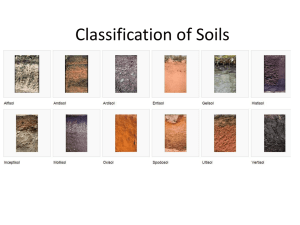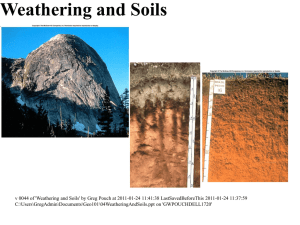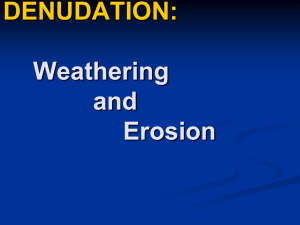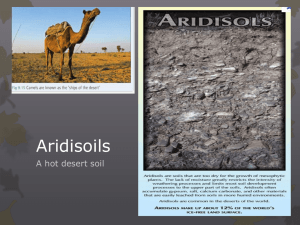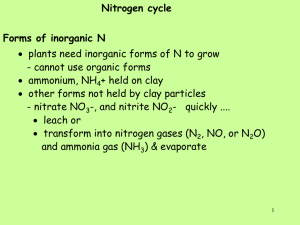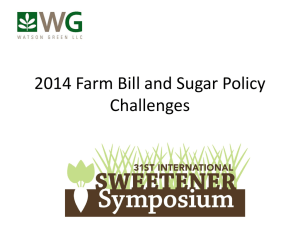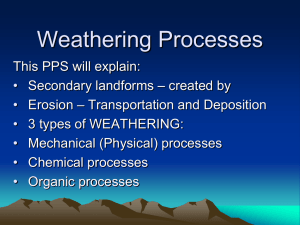UNIT-2-2014-DAY-2-AM-Activity-Weathering, Erosion and Soils
advertisement
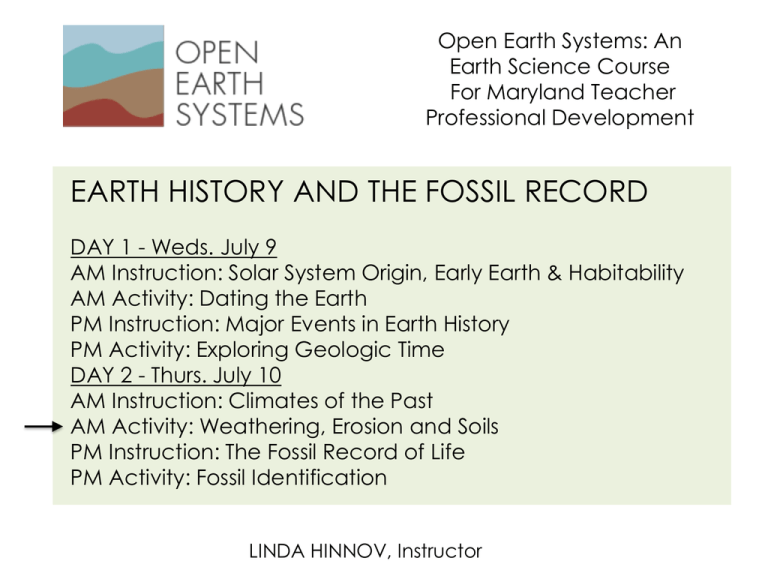
Open Earth Systems: An Earth Science Course For Maryland Teacher Professional Development EARTH HISTORY AND THE FOSSIL RECORD DAY 1 - Weds. July 9 AM Instruction: Solar System Origin, Early Earth & Habitability AM Activity: Dating the Earth PM Instruction: Major Events in Earth History PM Activity: Exploring Geologic Time DAY 2 - Thurs. July 10 AM Instruction: Climates of the Past AM Activity: Weathering, Erosion and Soils PM Instruction: The Fossil Record of Life PM Activity: Fossil Identification LINDA HINNOV, Instructor Weathering of Rocks Physical weathering is the mechanical fragmentation of rocks from stress acting on them from Earth surface processes. Chemical weathering involves chemical reactions between Earth surface chemistry (water) and minerals that progressively decompose solid rock. PHYSICAL CHEMICAL feedbacks Famous experiment: Griggs, 1936 heated and cooled cubes of granite 140ºC to 30ºC for the equivalent of 240 years of daily fluctuations, but nothing happened. That was dry, but with wetting, in ~2.5 years they fell apart !!! Major products of weathering: (1) fractured rock (2) regolith (includes soil) (3) ions in solution Weathering of Rocks Goldich Stability Series “Reverse Bowen Reaction Series” High temperature silicate minerals weather first…. Bowen Reaction Series Weathering of Rocks Plagioclase feldspar weathers to kaolinite ( soft white clay mineral) Weathering of Rocks Weathering of Rocks Ultisols in MD https://upload.wikimedia.org/wikipedia/commons/e/e5/Global_soils_map_USDA.jpg http://soils.usda.gov/technical/soil_orders/ http://soils.usda.gov/technical/soil_orders/ Ultisols have an ochric epipedon (surface soil) and an argillic or kandic horizon and are commonly calcium deficient. Most of these soils supported mixed coniferous and hardwood forest vegetation at the time of settlement. Some are now used as cropland or pasture. http://www.swac.umn.edu/classes/soil2125/doc/s5chp1.htm Udults are more or less freely drained, relatively humus poor ultisols that have a udic moisture regime The udic moisture regime is common to soils of humid climates with welldistributed rainfall, or which have enough rain in summer so that the amount of stored moisture plus rainfall is approximately equal to, or exceeds, the amount of evapotranspiration. Water moves down through the soil at some time in most years. ftp://ftpfc.sc.egov.usda.gov/NSSC/E ducational_Resources/conce pts2.pdf ftp://ftpfc.sc.egov.usda.gov/NSSC/Educational_ http://www.soils.wisc.edu/ Grain sizes in soil ftp://ftpfc.sc.egov.usda.gov/NSSC/Educational_Res ources/concepts2.pdf USDA Soil Textural Triangle ftp://ftpfc.sc.egov.usda.gov/NSSC/E ducational_Resources/conce pts2.pdf ftp://ftpfc.sc.egov.usda.gov/NSSC/Educational_ Resources/concepts2.pdf ftp://ftpfc.sc.egov.usda.gov/NSSC/Educational _Resources/concepts2.pdf Stony Run soils completely “reworked” (no original soil profiles!) Gneiss bedrock



